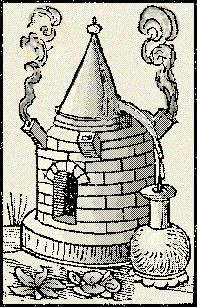Distillation
Though the alchemists tried to keep the art of distillation a closely guarded mystery, the technique soon became widespread. In fact, distillation became one of the activities of the housewife.
Ye shall lay sand under the pan of [the still] four inches of thickness. Thereupon ye shall set your pan of earth[enware] either leaded or glazed, or else of copper. Then lay therein such things as ye shall distil and set the helm* upon it, then make a long small linen cloth wet in thin clay. . . with the same cloth you shall stop [seal] your stillatory between the helmet and the pan. Then set a glass before it that the pipe [of the helm] hang in the glass; then distil.
(From Hieronymous Braunschweig, De Arte Distillandi 1527, translated by Laurence Andrewe.)
Varying heats were used for distillation, ranging from the warmth of decaying horse dung or the mild heat of the sun to the heat of fire insulated by ashes or sand (as in the example quoted); the hottest was achieved when the glass was "set boldly. . . upon the fire and nothing between the fire and it but only an iron grate or an iron trivet."
Footnotes
-
The helm
The helm, also known as the alembic or limbeck, was usually cone-shaped, with a spout coming from the lower lip to drain off the condensed liquid.
